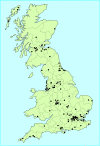Current status of long term ventilation of children in the United Kingdom: questionnaire survey
- PMID: 9924054
- PMCID: PMC27711
- DOI: 10.1136/bmj.318.7179.295
Current status of long term ventilation of children in the United Kingdom: questionnaire survey
Abstract
Objectives: To identify the number and current location of children, aged 0 to 16 years, requiring long term ventilation in the United Kingdom, and to establish their underlying diagnoses and ventilatory needs.
Design: Postal questionnaires sent to consultant respiratory paediatricians and all lead clinicians of intensive care and special care baby units in the United Kingdom.
Subjects: All children in the United Kingdom who, when medically stable, continue to need a mechanical aid for breathing.
Results: 141 children requiring long term ventilation were identified from the initial questionnaire. Detailed information was then obtained on 136 children from 30 units. Thirty three children (24%) required continuous positive pressure ventilation by tracheostomy over 24 hours, and 103 received ventilation when asleep by a non-invasive mask (n=62; 46%), tracheostomy (n=32; 24%), or negative pressure ventilation (n=9; 7%). Underlying conditions included neuromuscular disease (n=62; 46%), congenital central hypoventilation syndrome (n=18; 13%), spinal injury (n=16; 12%), craniofacial syndromes (n=9; 7%), bronchopulmonary dysplasia (n=6; 4%), and others (n=25; 18%). 93 children were cared for at home. 43 children remained in hospital because of home circumstances, inadequate funding, or lack of provision of home carers. 96 children were of school age and 43 were attending mainstream school.
Conclusions: A significant increase in the number of children requiring long term ventilation in the United Kingdom has occurred over the past decade. Contributing factors include improved technology, developments in paediatric non-invasive ventilatory support, and a change in attitude towards home care. Successful discharge home and return to school is occurring even for severely disabled patients. Funding and home carers are common obstacles to discharge.
Figures
Comment in
-
Eligibility criteria improve children's access to long term ventilation at home.BMJ. 1999 Jun 19;318(7199):1699. doi: 10.1136/bmj.318.7199.1699a. BMJ. 1999. PMID: 10373190 Free PMC article. No abstract available.
References
-
- Simonds AK. From intensive care unit to home discharge in the 24 hour ventilator-dependent patient. Eur Respir Mon. 1998;8:364–379.
-
- Frates RC, Splaingard ML, Smith EO, Harrison GM. Outcome of home mechanical ventilation. J Pediatr. 1985;106:850–856. - PubMed
Publication types
MeSH terms
LinkOut - more resources
Full Text Sources
Miscellaneous

